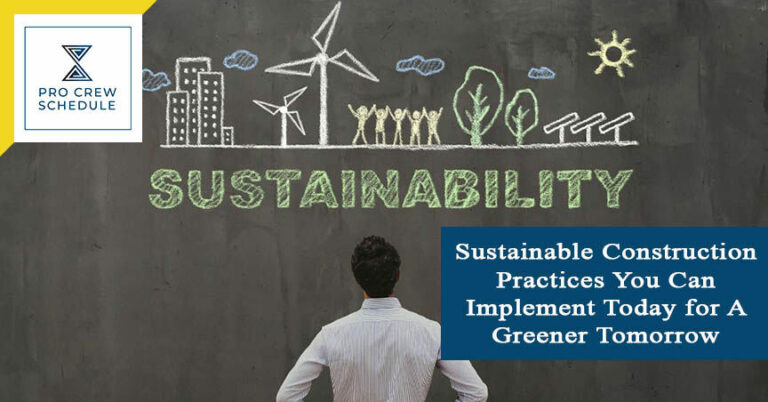The construction industry is known as one of the big users of natural resources around the globe. Some of the growing environmental issues of our generation, such as the finite number of natural resources and climate change, can be pointed back to construction. Knowing this, there is increasing pressure in the industry to reduce and possibly eliminate the environmental impact that construction brings.
Major revisions in the building codes, new regulations, and the rise of various construction software are slowly changing the boundaries of what is expected for construction. Technological advancement is also paving the way for future possibilities regarding building energy usage. While adapting sustainable construction processes can be challenging, the benefits outweigh them all.
But first, let’s clarify- what is sustainability in the construction industry?
What is Sustainable Construction?
The idea of sustainability was introduced decades ago when climate change was at its peak. Climate change then became a global concern that alarmed the world, and our ancestors knew that something had to change, especially in the high-contributor industries.
In architecture, sustainability translates to limiting the environmental effects of building, substituting traditional building materials with sustainable counterparts, implementing energy-efficient designs, and creating proper waste management systems in construction projects.
In civil engineering, sustainability involves:
- Using modular construction.
- Adapting Artificial Intelligence (AI) and Virtual Reality (VR) in construction.
- Implementing construction process improvement software for efficiency.
However, these two disciplines share the same goal in using sustainable practices: to reduce the risk of the environmental impact of construction in the long run.
Why Shift from Traditional to Sustainable Construction Processes?
Apart from the loss of agricultural and wild habitats from the development of field sites, energy is used on-site, especially during the construction phase. Heavy equipment used in construction operations still depends heavily on fossil fuels. The construction industry is also liable for the embodied energy in building materials and the amount of the building’s energy needs when in use.
The manufacturing and shipping of building materials (prefabricated or not) can considerably impact carbon emission production. Mining for various raw materials can result in polluted bodies of water. Cement production, a main building material, contributes the most to carbon emissions. With the current rise of urbanization, it is expected to increase just as fast.
What are the Three Major Benefits of Sustainable Construction?
Implementing sustainable construction practices in your business can give you the following benefits among your competitors:
1. Social Benefits
With sustainable construction, not only the occupants get the benefits, but also the workers who adopt sustainable practices. Workers who work on sustainable projects tend to have improved health and overall well-being due to a better work environment, surroundings, and added noise protection. Time management in construction also improves because of the productivity boost workers experience in this type of setting.
After the construction phase ends, the occupant of the sustainable building experience the same benefits. Not only is this good for the people you work with and for, but it is also very good for the business. What’s better than hitting two birds with one stone?
2. Environmental Benefits
Sustainable construction methods can not only eliminate or reduce the negative impacts on the environment, but they can also positively impact our ecosystem. Since green buildings use less energy, water, and natural resources, there is also an improvement and emission and waste management in construction projects. Moreover, using recycled building materials and renewable energy sources, sustainable practices can also pave the way in fighting climate change.
3. Financial Benefits
One of the top criticisms of green buildings is how expensive they can become since it’s using more expensive materials than conventional construction projects. However, during this time of innovation and advancement, sustainable options are considered more valuable than traditional ones. Green buildings have more value than traditional buildings, now and in the future, which is a win-win investment for both the project owner and the contractor.
Tenants of construction buildings are also to expect huge savings in water and electricity bills due to their well-thought conceptualization and design. Yes, green buildings are expensive initially, but traditional buildings are more costly in the long run.
What are Green Building Certifications that Contractors Should Know?
Green building certifications are needed to achieve the green building standard. Below are some of the most well-known certifications in the construction industry:
1. ASHRAE (American Society of Heating, Refrigerating, and Air-Conditioning Engineers)
– This organization’s vision is a sustainable and healthy environment built for all.
2. LEED (Leadership in Energy and Environmental Design)
– Known as the most famous green building certification in construction, LEED is also the most widely used green building rating globally.
3. Estidima
– Estidama, which is the Arabic translation for sustainability, is a worldwide initiative developed and promoted by the DPM.
4. Mostadam
– Mostadam is another green building rating system formulated by the Ministry of Housing of the Kingdom of Saudi Arabia, which is administered by Sustainable Building.
Sustainable Construction Processes You Can Implement Now in Your Construction Projects
If all these sustainability concepts overwhelm you, fret not, as we have prepared a list of practices you can adapt to your construction projects, one green step at a time.
1. Plan Ahead
One of the best ways to produce a green construction project is to incorporate sustainability right at your team’s planning and design phase. Construction Scheduling Software can be very useful at this stage of your project. This simple adjustment can give you a bird’s eye view of how to make necessary changes to your traditional construction practices, insert sustainable alternatives, and schedules the revisions accordingly.
2. Maximize Prefabricated and Modular Construction Technology
Modular and prefabricated practices directly correlate to innovative and more sustainable construction. Designing prefabricated and modular components allows for reduced rework and materials and quicker build times. When conceptualizing modular components, one can also consider the reusability of each component – will they easily adapt to future demands and changes in the industry? When combined with construction time tracking software, building in bulk with prefabricated or modular methodologies can also reduce green costs for lower-carbon alternatives.
3. Minimize Embodied Carbon Production During Construction Operations
There are several ways to reduce embodied carbon production in construction operations: use smarter manufacturing equipment and tools, embrace BIM and advanced technology solutions to reduce rework, and construct modular prefabricated components when possible.
Waste management also has a big role in minimizing carbon production. Proper waste management can eliminate and reduce waste and materials that might otherwise end up in the wasteland. Reducing, recycling, and reusing construction waste is essential to proper waste management in creating sustainable construction projects.
Lastly, always opt for non-toxic construction building materials or raw/natural materials that haven’t been substantially processed before using on-site. These materials don’t contain chemicals that release toxic gases, which are harmful to both the people and the environment.
4. Adapt Local Sourcing of Materials and Just-in-time Procurement Method
Just-in-time material procurement consolidates raw-material orders from suppliers with construction inventory software. This practice reduces the risk of unused or excessive orders of construction materials. Sourcing building materials locally eliminates transport and carbon emissions. Your company also gives an opportunity for local businesses and communities to thrive. Not only does it help with your environmental and financial goals, but this also boosts your social aspect.
5. Incorporate Construction Inventory Management into the Planning Phase
If your business plans to move toward greater sustainability, green materials and methodologies need to be accounted for early in the initial design phase. The team must design based on the currently available assets instead of expecting possible demolition and rebuilds. The team also needs to design according to each building component’s asset lifespan and reuse potential.
Using life cycle assessment (LCA) in the design phases lets you choose materials with the lowest carbon impacts. Once sustainability is part of your design and construction backbone, it leads to low maintenance costs, enjoyable spaces to work, and extending the life of the building and its reuse potential.
6. Adopt the “Shoot for the Moon” Mindset
When it comes to innovation, we need a “shoot for the moon” mindset that aims to achieve a goal others might consider outright impossible. This motivational way of looking at things empowers you to seek solutions instead of possible roadblocks. This mindset is essential when creating the pathway for our clients to embrace sustainability that aligns with their financial benefit. We need to make it manageable for them to switch to green construction.
7. Standardize Scale Sustainable Solutions Worldwide
To make the greatest impact, sustainable solutions in the construction industry should be scalable and standardized around the world. One of the major problems in the industry is the division of methodologies, technology, and more. In order to counteract this, the industry needs to stand to standardize and share the solutions at a broader scale. So how can this be achieved? It starts with policy. Companies, cities, and countries need to adopt stronger programs and policies to reduce the impact of construction.
Sustainability is the future.







